1906 Moscow Kremlin Egg
Gift Nicholas
II to Alexandra Feodorovna
Made in Saint Petersburg
Owner: Moscow Armoury Museum, Russia
Height: 36,1 cm
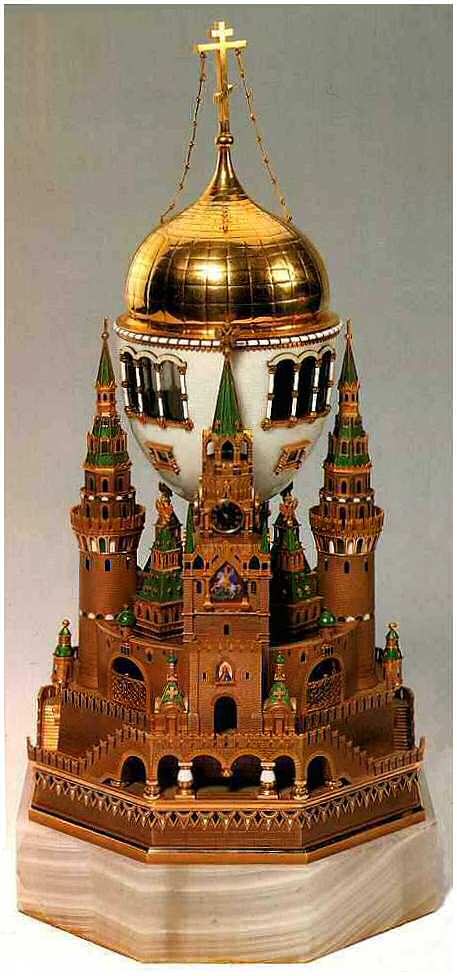
The 1906 Moscow Kremlin Egg, also known as "Uspensky Cathedral Egg" is made of onyx, quatre-couleur gold, white and green enamel, glass and oil painting.
The largest and most ambitious of the known Fabergé Eggs, represents the Cathedral of the Assumption (Uspensky) in the Moscow Kremlin where once all Russian Tsars were crowned. An enameled gold composition centered on the egg-shaped dome of the Cathedral of the Assumption, in white opalescent enamel, the interior of the church with its carpets, tiny enameled icons and High Altar on an oval glass plate, made visible through the glass windows, surmounted by a gold cupola, flanked by two square and two circular stylized turrets, the former based on the Spasskaya Tower, bearing the coat of arms of the Russian Empire and of Moscow and inset with chiming clocks. Two Cherubim chants, traditional Easter hymns, are played when a clockwork mechanism is wound up by a gold key, two and a half inches long.
The Egg rests on an octagonal white onyx base, designed a s pyramid and built up of smaller pyramids. Engraved at he foot in white enamel on a round gold plate is the date, "1904" (!)
Background information
The magnificent Moscow Kremlin Egg commemorates the return to Moscow of the Imperial couple in 1903. (See the 1897 Coronation Egg). They had tended to avoid the capital following the disaster during the celebrations to mark their coronation. Hundreds of Muscovites died, crushed to death, when a crowd ran amok in Khodynka Meadow. Many russians took the tragedy as a bad omen for the reign of the new tsar.
The Egg was to have been presented in 1904 (hence the date on the base) but was delayed possibly because of the Russo-japanese War. Another disaster is connected with this Egg. Nicholas II's favorite uncle and brother-in-law, Grand Duke Sergei Alexandrovich, was assassinated in the kremlin by a terrorist early in 1905, the first and only time a member of the ruling dynasty was murdered in the ancient citadel of the Moscow Tsars. This may have delayed the presentation of the Egg for a second time. Nicholas II did not receive the Egg until 1906 and the bill of sale was not presented until that year.
Despite these sad associations, the Moscow Kremlin Egg held the most prominent position in Alexandra Feodorovna's display cabinet in her Sitting Room in the Alexander Palace.
The Moscow Kremlin Egg was never sold and is one of the ten Eggs in the Armory Museum of the Kremlin in Moscow.
Update November 2016
Beautiful Images of the Egg while on view in Wien, Österreich, including a view in the coupola! Photos courtesy https://artinwords.de/die-welt-von-faberge/
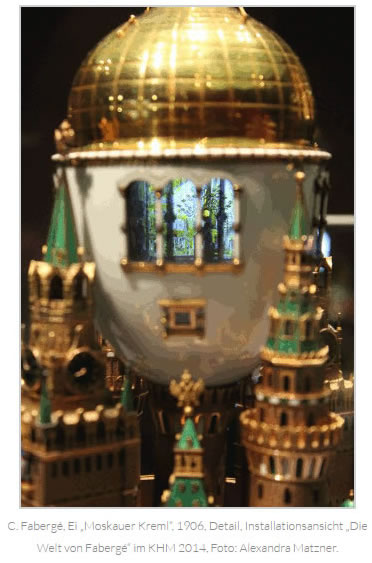
March 2018 - New images, and text, all courtesy Romanov News!
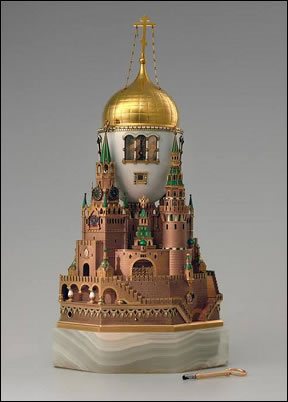
The Egg seen sidelong with the small key to wind the musical box
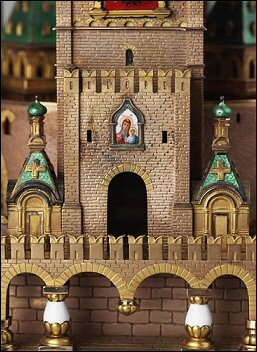
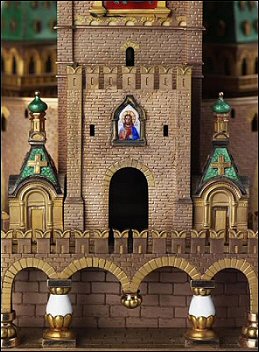
Miniature enamel icons "Our Lady of Kazan" and "Christ the Almighty" (right)
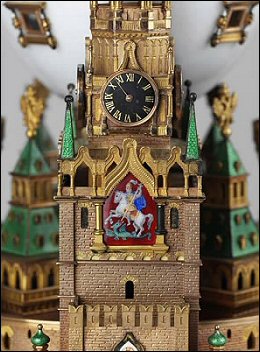
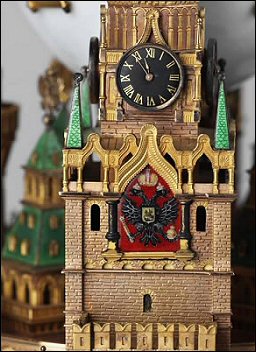
Spasskaya Tower with the emblems of the Russian Empire and Moscow
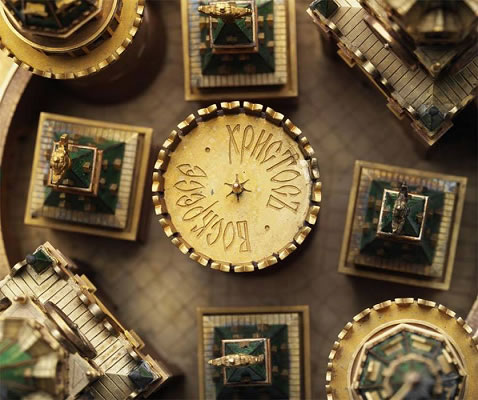
Seen from above, with the Egg itself removed, you can see the various towers with right in the middle a little round commemorative plaque with the words "Христос воскресе" (Christ is Risen) the Paschal Greeting, or Easter Acclamation.
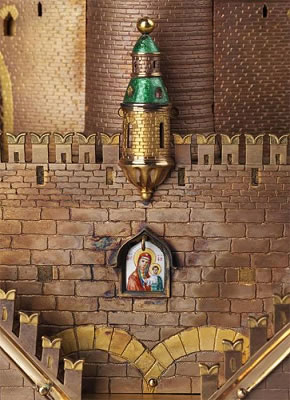
Detail of the second icon "Our Lady of Kazan"
Egg "Moscow Kremlin" is rightfully considered a symbol of the Kremlin collection of Faberge products. Carrying out this unusual for design work, the masters of the company tried to create an image of the ancient Moscow Kremlin, both magnificent and fabulously elegant. The task of making its model was done, so the egg is a fantasy variation on the theme of the Kremlin walls, towers and churches.
Its decor, covered with white transparent enamel and crowned with a polished golden dome, is inspired by the architecture of the Assumption Cathedral. In one of the glazed windows you can see the festively illuminated interior of the church, made on the inside of the oval glass plate. You can see the grandiose iconostasis, the royal place and the front massive pillars with fresco paintings.
Stand of red gold is a double-reproduced Spassky and Water-towers, interconnected by walls with bizarre fantasy grilles. On the Spasskaya Tower there are the emblems of the Russian Empire and Moscow, and in the cottages above the gates there are miniature enamel icons "Our Lady of Kazan" and "Christ the Almighty".
The egg-cathedral is high above the stand, its shining golden dome hovers above the enamel roofs of the towers. Three levels are clearly expressed, connected by the staircases climbing up to the church with numerous stairs.
In the virtuoso jewelry work with the golden dome of the Assumption Cathedral, in which the symbol of autocratic power was seen, the idea of an ascent to God and spiritual perfection of man was also embodied.
During a visit to Moscow the august couple at Easter in 1903 there was a small episode that did not escape the attention of the press, however. Nicholas II really liked the "Cherubic", which the choir performed during the Liturgy in the Assumption Cathedral of the Kremlin. The emperor praised the singing and asked the director of the synodal choir who is the author of the music; it was the composer A. D. Kastalsky.
The court master probably knew the story of the "Cherubic", so he decided to voice his complex jewelery design created by stone-cutters, enamelers, miniature artists and jewelers of the firm. The egg has a musical mechanism, it is wound up with a golden key, and then the magic cherubic melodies that was liked so much by the tsar - a festive Easter hymn.
Egg "Moscow Kremlin" - a grand and complex creation of the firm K. Faberge, is the largest of the Imperial Easter eggs, stored in the Armory Chamber.
Text and images above, source Romanov News.
Page updated or corrected: March 31, 2018
